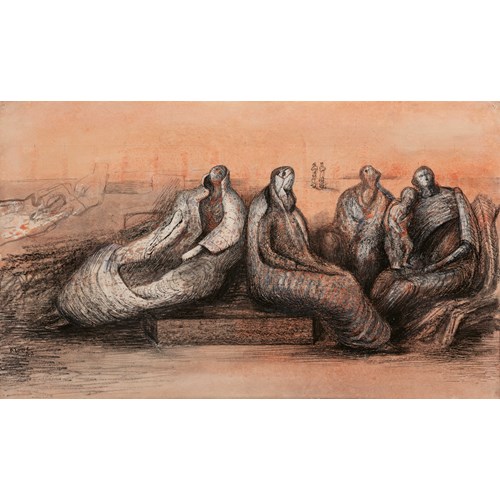Marketplace
Portrait of a Prisoner, Looking Down to the Right
Jean-Pierre LAURENS
Portrait of a Prisoner, Looking Down to the Right
Medium Pen and brown ink and brown wash, and watercolour
Dimension 19.8 x 26 cm (7³/₄ x 10¹/₄ inches)
On 25 September 1914 Laurens was wounded by a bullet in his right leg and taken prisoner by the Germans. He was transferred to the prisoner of war camp at Wittenberg, on the Elbe river in Saxony-Anhalt, which became notorious for its appalling conditions, with 15,000 French, Belgian, British and Russian prisoners of war confined in overcrowded and unsanitary conditions. During his three years as a captive at Wittenberg, Laurens produced a number of drawings and watercolours of everyday life in the camp and of his fellow prisoners. These drawings recorded the harsh conditions of captivity and, in particular, the ravages caused by the typhus epidemic in the camp in 1915.
The present sheet is likely to depict a Russian prisoner of war in the camp at Wittenberg. Laurens made several drawings and watercolours of his fellow prisoners. As the artist recalled of his time in the camp, in a letter written after the war, ‘As soon as it was possible, I started to draw my comrades on a piece of paper, and then I was able to obtain a small album. A great day was the arrival of a block [of paper], paintbrushes and colours. This coincided with the arrival of the Russians in our hut. They had been in the camp for a month, but we had not been able to see them up close. I was in awe of the grandeur of their appearance and had a burning desire to work on drawings of them. Events made it easier for me. When I received the paper, the barracks offered a sight that you cannot imagine. We had the Russians and the colonial riflemen. They were beautiful too. An unusual mix.’
It may have been the arrival of Russian prisoners at Wittenberg that led to the typhus epidemic and the subsequent quarantine, which lasted for about six months, until the summer of 1915. During this time of isolation, with the prisoners having little or no direct contact with the Germans outside the barbed wire, Laurens was able to work relatively freely. As he wrote in a letter of July 1915, ‘I have adopted a Russian barracks in which I draw very often…I put all my effort into keeping it together. It’s difficult. It always comes between you and nature. To give chase is hard work. To look at a human face with an absolutely pure heart is an arduous test for one who has dedicated his life to the expression of visible forms. I have convinced myself of this here.’
The present sheet may depict the same Russian prisoner who appears in several other 1915 watercolours by Laurens. In one of these the sitter is identified as ‘Yosef’, who is mentioned by the artist in a letter: ‘If you only knew what kind of people I have lived among! In the misery of the beginning, when I painted the head with half-closed-eyes and purple lips of poor Yosef, the Muslim from Siberia...’
The present sheet is likely to depict a Russian prisoner of war in the camp at Wittenberg. Laurens made several drawings and watercolours of his fellow prisoners. As the artist recalled of his time in the camp, in a letter written after the war, ‘As soon as it was possible, I started to draw my comrades on a piece of paper, and then I was able to obtain a small album. A great day was the arrival of a block [of paper], paintbrushes and colours. This coincided with the arrival of the Russians in our hut. They had been in the camp for a month, but we had not been able to see them up close. I was in awe of the grandeur of their appearance and had a burning desire to work on drawings of them. Events made it easier for me. When I received the paper, the barracks offered a sight that you cannot imagine. We had the Russians and the colonial riflemen. They were beautiful too. An unusual mix.’
It may have been the arrival of Russian prisoners at Wittenberg that led to the typhus epidemic and the subsequent quarantine, which lasted for about six months, until the summer of 1915. During this time of isolation, with the prisoners having little or no direct contact with the Germans outside the barbed wire, Laurens was able to work relatively freely. As he wrote in a letter of July 1915, ‘I have adopted a Russian barracks in which I draw very often…I put all my effort into keeping it together. It’s difficult. It always comes between you and nature. To give chase is hard work. To look at a human face with an absolutely pure heart is an arduous test for one who has dedicated his life to the expression of visible forms. I have convinced myself of this here.’
The present sheet may depict the same Russian prisoner who appears in several other 1915 watercolours by Laurens. In one of these the sitter is identified as ‘Yosef’, who is mentioned by the artist in a letter: ‘If you only knew what kind of people I have lived among! In the misery of the beginning, when I painted the head with half-closed-eyes and purple lips of poor Yosef, the Muslim from Siberia...’
Medium: Pen and brown ink and brown wash, and watercolour
Signature: Signed Pierre Laurens at the lower right.
Numbered and dated III 1915 at the lower left.
Numbered 16 and III on the verso.
Dimension: 19.8 x 26 cm (7³/₄ x 10¹/₄ inches)
Provenance: By descent in the family of the artist.
More artworks from the Gallery









